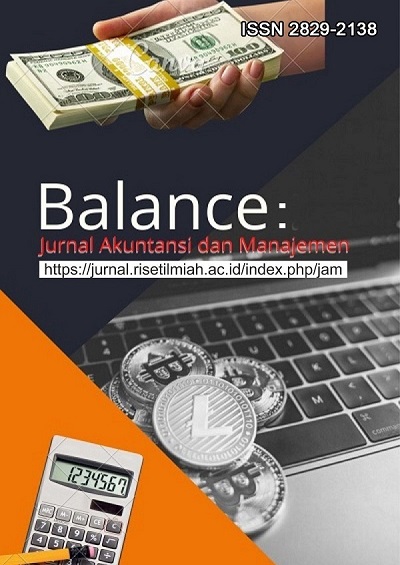ASEAN Economic Growth: The Influence of Inflation, Trade, and Industrial Policy
DOI:
https://doi.org/10.59086/jam.v4i1.610Keywords:
Economic Growth, ASEAN, Regression, Trade, InflationAbstract
Downloads
References
Akinsola, F. A., & Odhiambo, N. M. (2017). Inflation and economic growth: A review of the international literature. Comparative Economic Research. Central and Eastern Europe, 20(3), 41-56. https://doi.org/10.1515/cer-2017-0019
Arapova, E. (2018). Determinants of household final consumption expenditures in Asian countries: A panel model, 1991–2015. Applied Econometrics and International Development, 18(1), 121-140. https://www.usc.gal/economet/reviews/aeid1818.pdf
Aswicahyono, H., Hill, H., & Narjoko, D. (2013). Indonesian industrialization: a latecomer adjusting to crises. Pathways to industrialization in the twenty-first century: New challenges and emerging paradigms, 193-222. https://hdl.handle.net/10419/54055
Avirutha, A. A. (2021). ASEAN in digital economy: Opportunities and challenges. Journal of ASEAN plus Studies, 2(1), 17-25. https://so06.tci-thaijo.org/index.php/aseanplus/article/view/245334
Basuki, A. T., & Prawoto, N. (2019). Analisis Regresi: dalam Penelitian Ekonomi dan Bisni. Depok: Rajagrafindo Persada. https://repository.umy.ac.id/bitstream/handle/123456789/2051/C.2-NAno%20Prawoto.pdf?sequence=5
Bostan, I., Toderașcu, C., & Firtescu, B. N. (2018). Exchange rate effects on international commercial trade competitiveness. Journal of Risk and Financial Management, 11(2), 19. https://doi.org/10.3390/jrfm11020019
Cheang, B. (2024). What can industrial policy do? Evidence from Singapore. The Review of Austrian Economics, 37(1), 1-34. https://doi.org/10.1007/s11138-022-00589-6
Chen, Y. (2022). The review and analysis of inflation and its effects: Will current high inflation lead to an economic crisis. Journal of Business and Economic Policy, 9(2), 1-22. https://doi.org/10.30845/jbep.v9n2p1
Chong, S. H., Tun, Y. L., Shah, S. Z., & Rasiah, R. (2022). Environmental quality and economic growth: An empirical analysis in Asian countries. Environment-Behaviour Proceedings Journal, 7(21), 367-372. https://doi.org/10.21834/ebpj.v7i21.3676
De Koning, K. (2022). The US rise in inflation levels and the loss of purchasing powers. https://mpra.ub.uni-muenchen.de/113109/
De Ridder, M. (2016). Investment in productivity and the long-run effect of financial crises on output. https://dx.doi.org/10.2139/ssrn.2906232
Ekinci, R., Tüzün, O., & Ceylan, F. (2020). The relationship between inflation and economic growth: Experiences of some inflation targeting countries. Financial Studies, 24(1 (87)), 6-20. https://www.econstor.eu/handle/10419/231692
Erkisi, K., & Ceyhan, T. (2019). Trade liberalization and economic growth: A panel data analysis for transition economies in Europe. Journal of Economics Finance and Accounting, 6(2), 82-94. https://doi.org/10.17261/Pressacademia.2019.1047
Genc, E. G., & Artar, O. K. (2014). The effect of exchange rates on exports and imports of emerging countries. European Scientific Journal, 10(13), 128-141. https://core.ac.uk/download/pdf/236415296.pdf
Giang, M. H., Xuan, T. D., Trung, B. H., Que, M. T., & Yoshida, Y. (2018). Impact of investment climate on total factor productivity of manufacturing firms in Vietnam. Sustainability, 10(12), 4815. https://doi.org/10.3390/su10124815
Gujarati, D. N. (2021). Essentials of econometrics. Sage Publications. https://thuvienso.hoasen.edu.vn/bitstream/handle/123456789/9396/Contents.pdf?sequenc
Hartley, K., Woo, J. J., & Chung, S. K. (2018). Urban innovation policy in the postdevelopmental era: Lessons from singapore and seoul. Asia & the Pacific Policy Studies, 5(3), 599-614. https://doi.org/10.1002/app5.255
Haseeb, M., Hartani, N. H., Abu Bakar, N. A., Azam, M., & Hassan, S. (2014). Exports, foreign direct investment and economic growth: Empirical evidence from Malaysia (1971-2013). American Journal of Applied Sciences, 11(6), 1010-1015. http://dx.doi.org/10.3844/ajassp.2014.1010.1015
Herzer, D. (2011). The long-run relationship between outward foreign direct investment and total factor productivity: Evidence for developing countries. The Journal of Development Studies, 47(5), 767-785. https://doi.org/10.1080/00220388.2010.509790
Kang, J. W., & Dagli, S. (2018). International trade and exchange rates. Journal of applied economics, 21(1), 84-105. https://doi.org/10.1080/15140326.2018.1526878
Karadağ, H. (2016). The role of SMEs and entrepreneurship on economic growth in emerging economies within the post-crisis era: An analysis from Turkey. Journal of Small Business and Entrepreneurship Development. https://doi.org/10.1080/15140326.2018.1526878
Khan, N., & Naushad, M. (2020). Inflation relationship with the economic growth of the world economy. Available at SSRN 3542729. https://dx.doi.org/10.2139/ssrn.3542729
Litvinenko, I. L., Grabar, A. A., Tikhomirov, E. A., Tupchienko, V. A., Yudenkov, Y. N., & Gabidullina, C. F. (2016). Conditions and factors of the positive investment climate formation of social and economic system of the region. International Review of Management and Marketing, 6(6), 253-260. https://dergipark.org.tr/en/pub/irmm/issue/32100/355604
Mankiw, N. G., & Taylor, M. P. (2020). Economics. Cengage Learning EMEA. https://thuvienso.hoasen.edu.vn/bitstream/handle/123456789/11992/Contents.pdf?sequence=1
Marasanti, A., & Verico, K. (2024). The effect of uncertainty on inflation: Evidence in ASEAN. Journal of Developing Economies, 9(1), 143-157. https://doi.org/10.20473/jde.v9i1.48745
Mehrara, M., & Baghbanpour, J. (2016). The contribution of industry and agriculture exports to economic growth: the case of developing countries. World Scientific News, (46), 100-111. https://worldscientificnews.com/wp-content/uploads/2024/01/WSN-46-2016-100-111.pdf
Nasution, A. (2017). The government decentralization program in Indonesia. In Central and local government relations in Asia (pp. 276-305). Edward Elgar Publishing. https://doi.org/10.4337/9781786436870.00017
Nguyen, M. L. T. (2022). Foreign direct investment and economic growth: The role of financial development. Cogent Business & Management, 9(1), 2127193. https://doi.org/10.1080/23311975.2022.2127193
Nguyen, V. C., & Do, T. T. (2020). Impact of exchange rate shocks, inward FDI and import on export performance: a cointegration analysis. The Journal of Asian Finance, Economics and Business, 7(4), 163-171. https://doi.org/10.13106/jafeb.2020.vol7.no4.163
Nteegah, A., Nelson, M., & Owede, V. M. (2017). Trade liberalization and economic growth in Nigeria. International Journal of Social Science and Economics Invention, 3(2), 120-132.
Nyeow, P. N. (2023). Factors affect employee productivity in Malaysia manufacturing industry (Doctoral dissertation, UTAR).
Platitas, R. J. C., & Ocampo, J. C. G. (2025). From bottlenecks to inflation: Impact of global supply-chain disruptions on inflation in select Asian economies. Latin American Journal of Central Banking, 6(1), 100141. https://doi.org/10.1016/j.latcb.2024.100141
Siddiqui, K. (2010). The political economy of development in Singapore. Research in Applied Economics, 2(2), E4. https://eprints.hud.ac.uk/id/eprint/9187/
Soesastro, H., & Basri, M. C. (2005). The political economy of trade policy in Indonesia. ASEAN Economic Bulletin, 22(1), 3-18. https://muse.jhu.edu/pub/70/article/387907/summary
Solow, R. M. (1956). A contribution to the theory of economic growth. The quarterly journal of economics, 70(1), 65-94. https://doi.org/10.2307/1884513
Tan, K. S., & Bhaskaran, M. (2015). The role of the state in Singapore: Pragmatism in pursuit of growth. The Singapore Economic Review, 60(03), 1550030. https://doi.org/10.1142/S0217590815500307
Todaro, M. P., & Smith, S. C. (2009). Economic development. Pearson education. https://dvmtextbooks.wordpress.com/wp-content/uploads/2015/09/economic-development-todaro-and-smith.pdf
Valente, Riccardo. ‘Capital’Accumulation, Economic Growth and Income Distribution: Different Theories and 20th and 21st Century Evidence. Nierówności społeczne a wzrost gospodarczy, 2016, 46: 148-179. https://www.ceeol.com/search/article-detail?id=412471
Webster, T. J. (2014). Malaysian economic development, leading industries and industrial clusters. The Singapore Economic Review, 59(05), 1450044. https://doi.org/10.1142/S0217590814500441
Were, M. (2015). Differential effects of trade on economic growth and investment: A cross-country empirical investigation. Journal of african trade, 2(1), 71-85. https://link.springer.com/article/10.1016/j.joat.2015.08.002
Wooldridge, J. M. (2016). Should instrumental variables be used as matching variables? Research in Economics, 70(2), 232-237. https://doi.org/10.1016/j.rie.2016.01.001
Downloads
Published
How to Cite
Issue
Section
License
Copyright (c) 2025 Agus Tri Basuki

This work is licensed under a Creative Commons Attribution 4.0 International License.
This is an open-access journal. All works are published under the Creative Commons license CC-BY which means that all content is freely available at no charge to the user or his/her Institution. Users are allowed to read, download, copy, write, improve, and create derivative creation even for other lawful purposes, this license permits anyone to, as long as they cite and license the derivative creation under similar terms

This work is licensed under a Creative Commons Attribution 4.0 International License.
Most read articles by the same author(s)
- Agus Tri Basuki, The The Long- and Short-Run Effects of GDP, Labor Force, and Industrial Growth on Unemployment in Indonesia , Balance : Jurnal Akuntansi dan Manajemen: Vol. 3 No. 2 (2024): Agustus 2024
- Agus Tri Basuki, Assessing the Long-Term and Short-Term Influences on Trade Value in Indonesia: Evidence from Economic, Industrial, and Monetary Factors , Balance : Jurnal Akuntansi dan Manajemen: Vol. 3 No. 3 (2024): Desember 2024


















